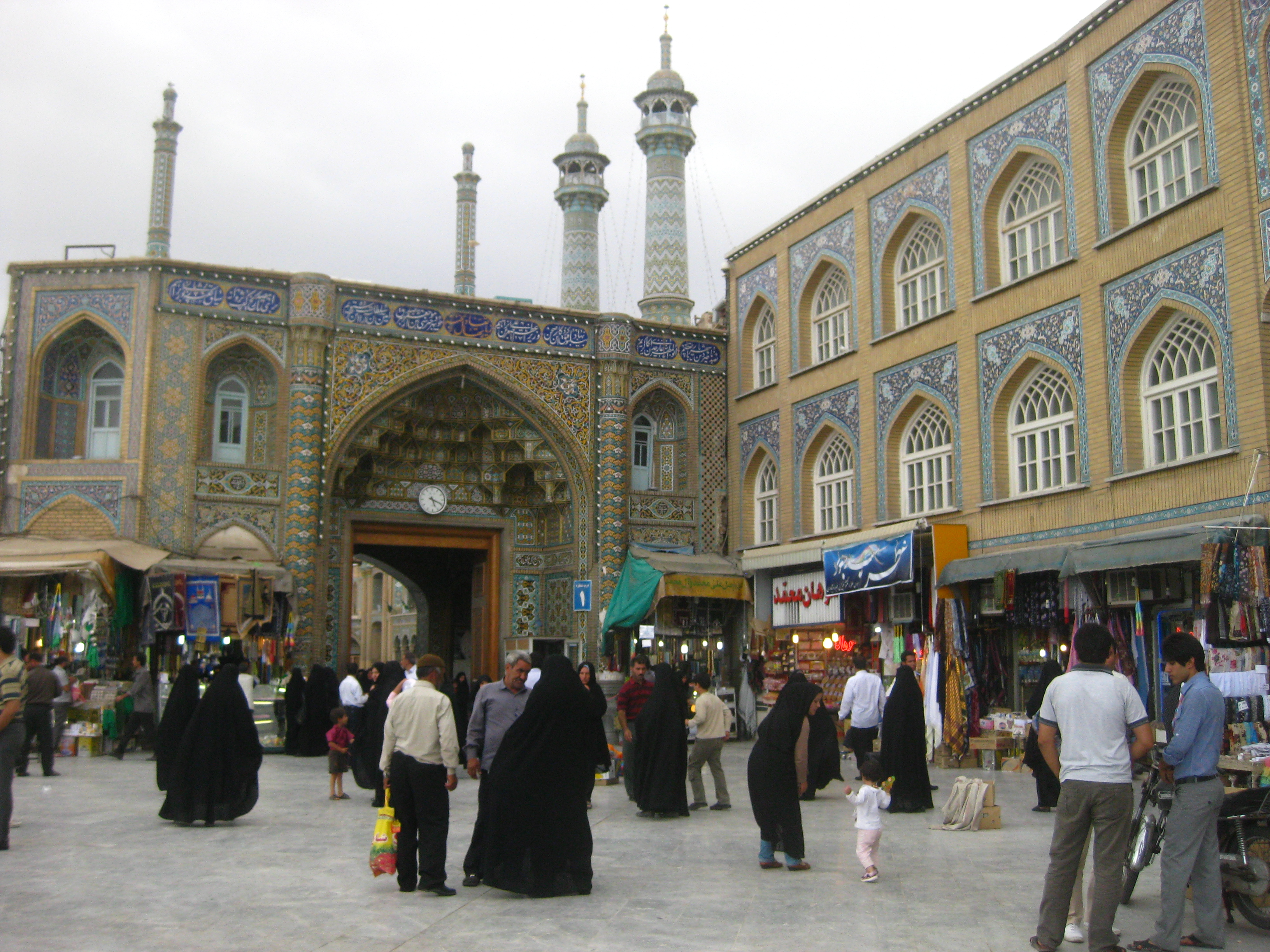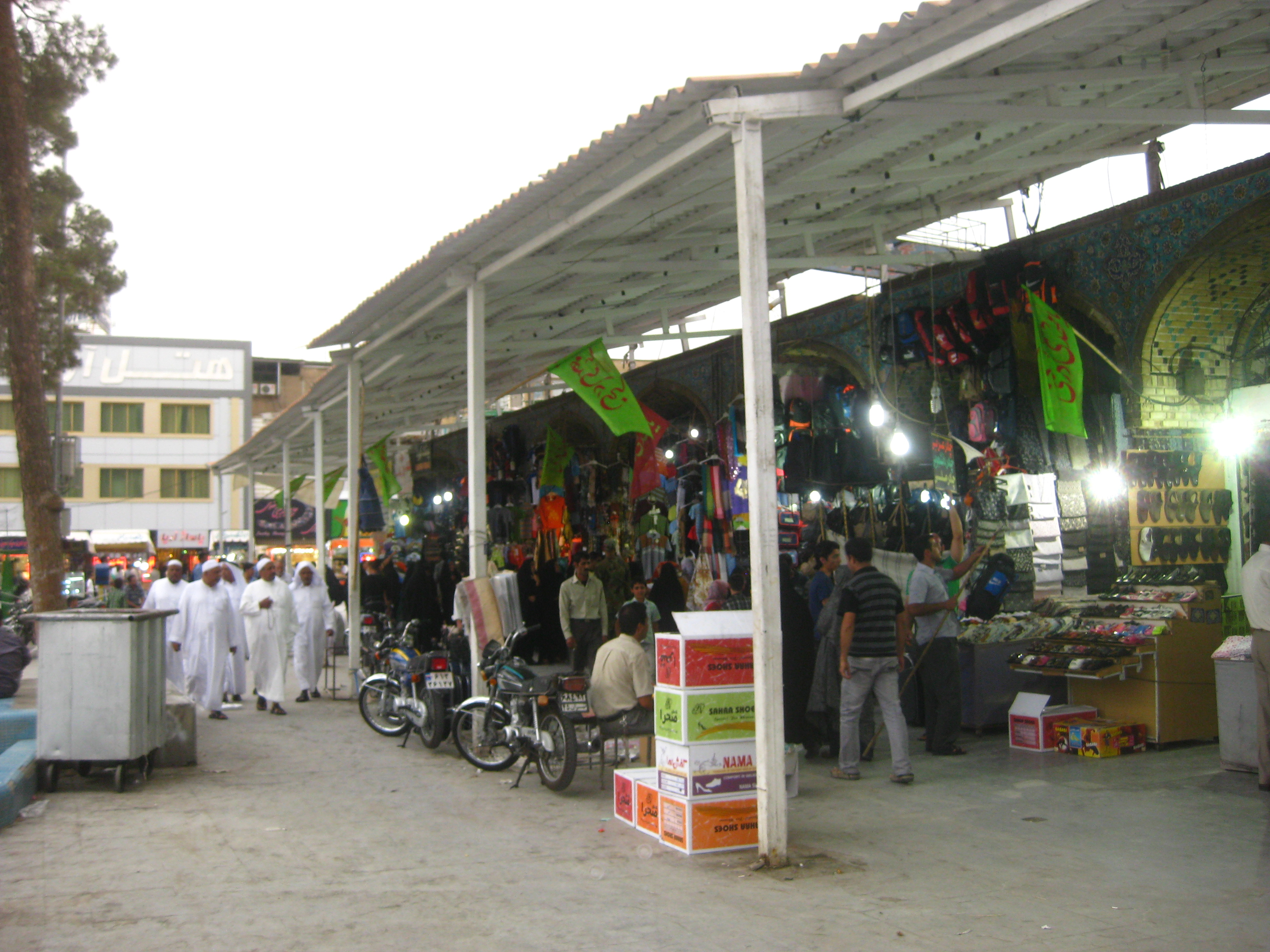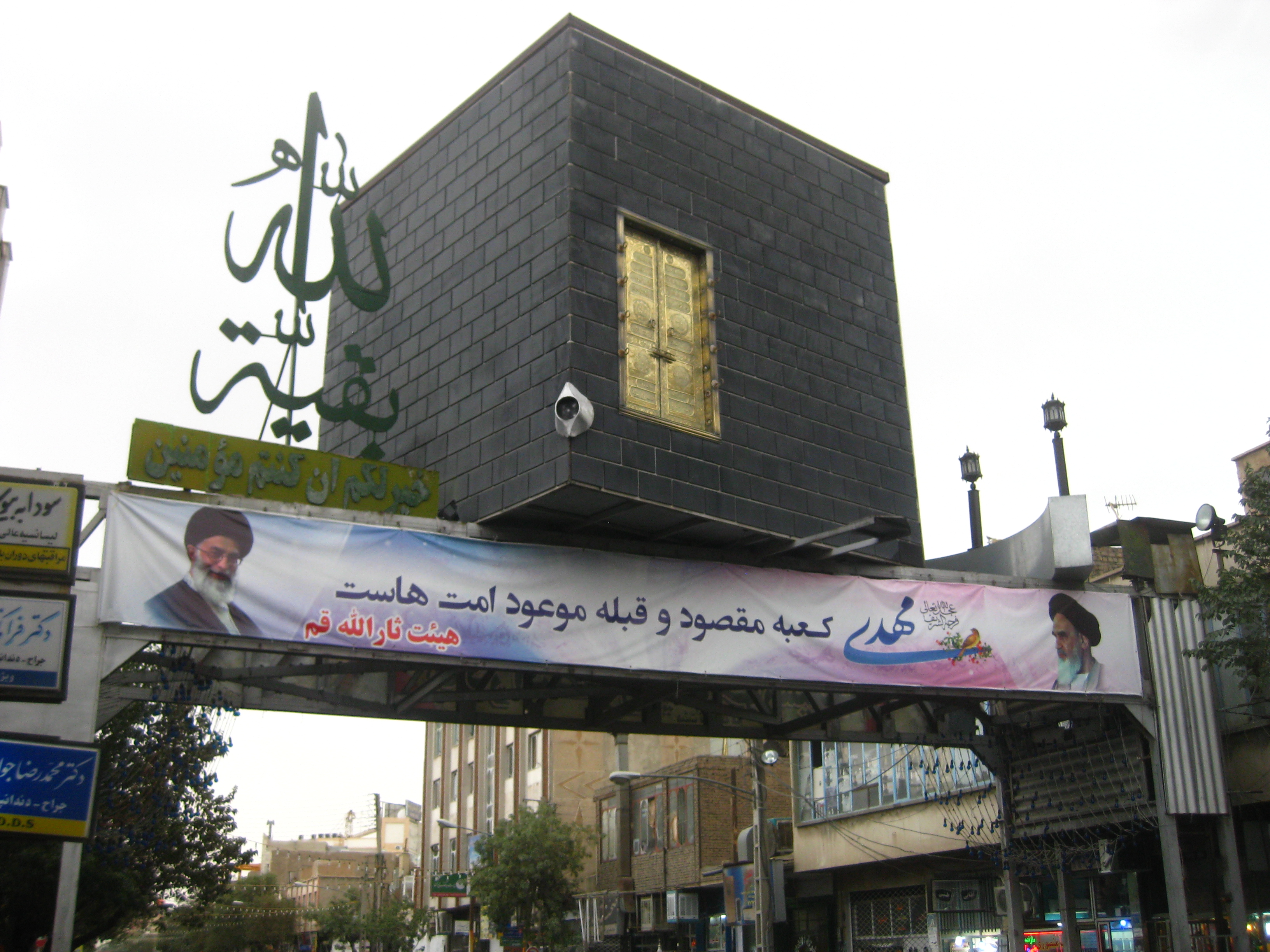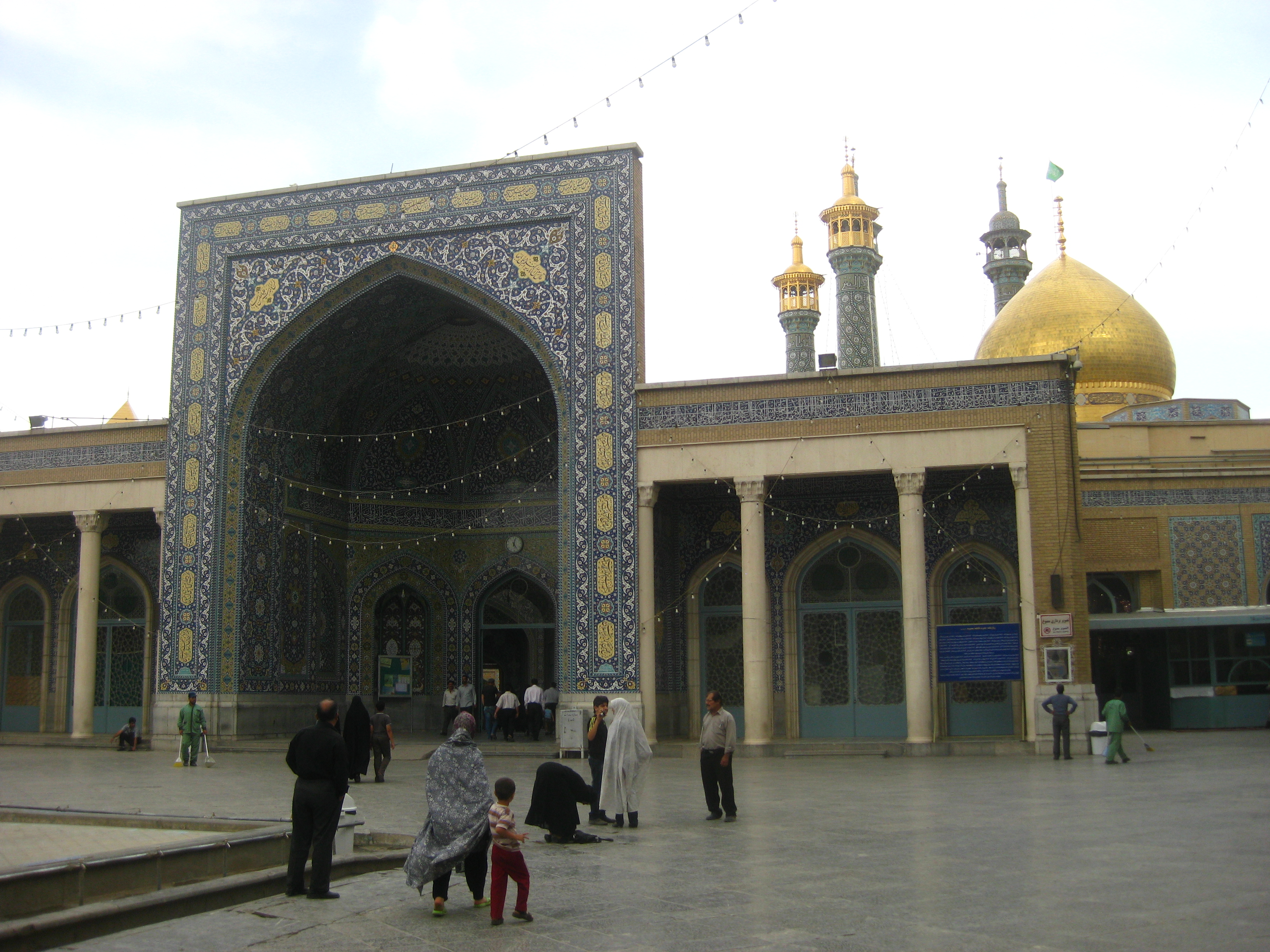The first glimpses of Qom are always a let-down. The approach begins about an hour into the journey south on the Tehran-Qom road, when, after a long stretch of craggy red hills and dusty desert, the bus reaches the top of its last peak. As it passes the summit and begins its final descent, laid before the passenger is a panorama of the same brownish-red color but now tarnished by an expansive mess of gray concrete dotted with high blue minarets and a huge gold dome, somewhat hidden from view by a screen of dense air pollution. Jerusalem it isn’t, but Qom’s pride as a hub of explicitly modernist Islamic theology is apparent in the humility and ugly utilitarianism of its drab cityscape.
It is upon emerging from the bus that the magic of Qom really hits you in the face. The center of the city is dominated by the Haram, the towering, gold-domed holy shrine of Hazrat-e Masoumeh that attracts around 15 million pilgrims from across the country and the region yearly. The river that used to pass beside this massive religious complex in the center of the city has been nearly covered shut with a double-decker highway. But for the millions of pilgrims who visit every year the freeway noise does little to diminish the beauty of the mammoth-turquoise blue archway that marks the entrance to the shrine’s grand mosque.
The shrine itself, a small room covered in intricate mirror mosaic, centers around the latticed metallic tomb of Fatima bent Musa al Kazem, the young sister of the 8th Shia Imam Reza. Fatima is revered by Shia Muslims for her religiosity despite her young age (she died at the age of 9 after being poisoned by the Abbasids while en route to see her brother in Mashhad), and is thus referred to as “Fatima the Immaculate.” The tomb is constantly surrounded by mourners whispering prayers to Fatima in the hopes that she will intercede on their behalf, giving the inner sanctum a rather somber feel.
And yet despite this, Qom’s holy shrine and central quarters have a positively carnivalesque atmosphere to them. The entire complex is surrounded by merchants sitting on sidewalks selling an array of spices, rugs, religiously-themed jewelry, and books, while a large bazaar containing the aforementioned products and a million other doo-dads opens up across the large courtyard that connects the shrine to central Qom. Meanwhile, on the city’s tree-lined main street sit dozens of fast food restaurants selling all variety of falafel, samosas, and shawarma in stands bedecked in Persian, Arabic, and Urdu signage.
Indeed, wandering through the rooms of the holy shrines, one is struck by the sheer diversity of the visitors that pray, sit and sleep in every corner of the place. From the clothes of the visitors more than half a dozen nationalities are easily identifiable- Iraqis, Bahrainis, and Saudis in light-colored gallabayas and black abayas with face coverings, Pakistanis and Indians in shalwar kameez and brightly-colored saris, Lebanese and Azerbaijanis in suits and headscarves or chadors, alongside a bewildering array of Iranian ethnic groups– Bandari Arabs in their distinctive multicolored abayas and metallic or leather facial masks, Turkmen and Khorasanis with Asiatic features and dark chadors, as well as Persians and Azeris in black chadors and tieless suits.
Many of the visitors, having traveled hundreds of miles with little money, stay in the shrine itself, and lines of clothes being let up to dry hang above the small pools that define the courtyards of most central Iranian mosques. While some visitors spend their time praying, reading, or visiting the other 21 holy sites in Qom, others wander the decidedly festive back streets of the city, looking for a cheap falafel or the perfect poster of one of the twelve Shia Imams, preferably Imam Hossein, to adorn their Karachi flat.
The etymology of the name “Qom,” is unclear but a saying holds that while Fatima the Immaculate was in the area, then named “Kom,” she saw the Devil and told him “Qom” which means “get up [and leave],” in Arabic. From this time, apparently, the name has stuck. Today, Qom is a byword for Shia theological learning, and sits alongside Najaf and Karbala as one of three largest concentrations of Shia seminaries in the world. Its most famous “Talabe,” an originally Arabic word which means “the one who requests” and that in Persian is applied to students here, is undoubtedly the previous Supreme Leader of Iran, Imam Khomeini. His doctrine of “Velayat-e faqih” (“Guardianship of the Jurist”), which seeks to combine the modern democratic state system and aspects of Shia doctrine regarding religious leadership, is the basis of Iran’s government today.
The down side of this reputation is that Qom is referred to in almost exclusively negative terms by those who are not devout Shias (and even many who are) both inside and outside of Iran. Foreign reporters routinely refer to the city merely as a “seminary city,” while some Iranians refer to it less politely as a “Talabe factory.” Iranians, who take great delight in mocking residents of each of this country’s regions for their perceived shortcomings (Esfahanis are cheap, Rashtis are stupid, Kurds are troublemakers), refer simply to the people of Qom as “badghomi,” which means, literally, “the bad people of Qom.”
Despite this reputation, in Qom, tourism is big business. Every year, about 300 million people worldwide undertake some kind of religious tourism according to the World Tourism Organization, and 15 million of those will be visiting Qom, the second-most visited site of religious tourism in Iran (after Mashhad). Religious tourism is by far the most important segment of Qom’s economy, beating out silk carpets and sweets by a wide margin, and has also made it one of the few places in Iran where cheap, decent Indian street food can be enjoyed.
For the world’s 200 million Shias, however, Qom is more than just a great place to get chapatti. As a locus for international pilgrimage, Qom brings together millions of people who have few commonalities except their Shi’ism and reinforces this transnational identity as a relevant source of meaning. Particularly given Shi’ism’s legendary historical status as a persecuted, minority religion, and the ongoing organized persecution of Shia Muslims in places like Pakistan, Iraq, Bahrain, and Saudi Arabia, religious pilgrimage tours to Iran serve as a kind of haven for many worshippers to practice their beliefs in peace and to be surrounded by fellow believers.
Besides this affirmation of a transnational Shia identity, religious tourism has also helped to influence discourse across the region and provided a mechanism for the transfer of ideas and the dissemination of theology. One simple example can be found in the spread of Shia religious iconography (and kitsch!). While today in a number of Arab countries and in dominant Arab Sunni religious thought images of the Prophet Muhammad and his relatives are considered to be forbidden, in Iran images of the Imam Ali, the cousin and son-in-law of the Prophet Muhammad and one of the most important religious figures in Islam, are widely distributed and are not frowned upon by neither the government nor the majority of people. As a result, many Arab religious tourists to Iran encounter images of the Imam Ali for the first time in Qom.

These images, however, have become widespread in some Arab countries like Lebanon and Iraq, and have become visible markers of a Shia identity. They also serve to reinforce a sort of orthodoxy of practice across the Shia world, as the image of the fair-skinned Imam Ali currently popular in Iran (which most Iranians will admit is probably not an accurate illustration) has become, as a result of Iran’s centrality as a site of pilgrimage for the Shia world. So far, this author has seen the same image of Imam Ali that sat over his family’s dining table in Tehran as far as East as Varanasi, as far West as Beirut, and as far South as Sana’a. The implications of the ongoing trans-nationalization of Shia identity are widely apparent in a growing sense of a collective, politicized Shia identity that is emphasized across the region in Friday sermons and internet forums. It is also manifested in the reactions of millions of Shia Muslims to the civil war in Iraq and the ongoing democratic uprising in Bahrain, reactions which have cemented the idea of a collective global Shia movement for millions of Sunnis.
Over the last two hundred years, Qom and its seminaries have served as a religious counterweight to the Iranian political authority based in Tehran. However, along with the political changes which have been shaking Iran since the 1970s, Qom’s position has altered. The city is now emerging as a global actor in an increasingly transnational Shia political identity. Given Qom’s recent development as a center of religious tourism for Shia Muslims across the region, its influential position is likely to remain high.
This article was originally posted on Mashallah News.




















6 comments
I doubt you will see Turkmens, who are pretty monolithically Sunni, making pilgrimage to Qom. Unless you meant Iraqi Turkmens, who use the name and familial affiliation ‘Turkmen’ but share more linguistically and culturally with Iran’s Azeris. Or perhaps you are mistaking Afghan Hazaras for Turkmens. Also “Talabe” (talaba) means student as well in Arabic, it is not unique to Persian.
They very well could have been Turkmen from elsewhere; I took them for Turkmen because they were wearing this hat (http://temp.musicfortheeyes.com/wp-content/uploads/2010/09/Manintelpak_yaluker.jpg) which I associate with Turkmen, though they could have very well been from a nearby area where the hat is also worn!
Also, from what I understand, “طلبه/طلبة” in Arabic is one plural of “طالب” (the other being “طلاب”), but in Persian it is generally used to mean a singular, male student. Could be wrong though